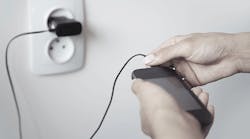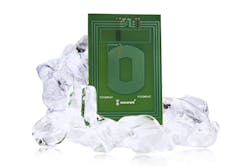Here is his recent Q&A with Electronic Design Technology Editor Maria Guerra:
Wireless chargers technology took off in 2012. How fast is this technology growing?
Babcock: The wireless power industry has arrived and is still estimated to experience 85% CAGR through 2020. In 2013, 25M products with wireless power embedded shipped worldwide; in 2014, 60M units; and in 2015, 220M units shipped worldwide. There was over 3x growth in the last year alone! In a market that is already worth nearly $2B and growing rapidly—similar to WiFi in 2006—it’s a very exciting time for wireless charging companies like NuCurrent.
Though the industry growth is substantial because the use case is so strong, there have been industry challenges regarding standards, licensing confusion, and so on. For some companies, this uncertainty and multiplicity has caused them to pause certain types of development for fear of having to choose sides. However, our technology helps to reduce some of this anxiety and lends to all types of wireless power and we structured ourselves to work across technologies (i.e., to handle and make the changes work for us and our customers). We do Airfuel Alliance A4WP & PMA, we do Qi, and we do proprietary frequencies. We do A4WP, Qi, PMA, and NFC all in one antenna substrate, too (aka “multimode”).
What role do wireless charger antennas play in the Internet of Thing (IoT)?
Babcock: IoT applications range from ultra-low-power sensors to large, power hungry machines that are sharing data. Ultra-low power devices are well served by energy harvesting techniques. High power devices will likely need corded power for the next few years. Within the middle of that spectrum (let’s say 500mW-500W) there are many IoT applications that can benefit from being cord-free. By removing the cord, we enable IoT applications and use cases that may have once been a stretch for the imagination.
We are enabling a new set of applications: IoT in ultra-small form factors. Imagine reusable security cards with indoor monitoring for agencies to track a maintenance contractor team as they move about a building or work site. Or a thin credit card you can take on a morning run with GPS for fitness tracking, safety and access to chai tea lattes.
We also reduce cost for the consumer: Consumers can purchase new IoT devices without constantly buying chargers for each application. It’s a green technology from this standpoint.
Wireless charging is IoT: Finally it should be noted that chargers not only enable IoT, but themselves can be IoT devices with ability to look at power usage, human behavior statistics and more. Imagine dropping your wallet on a charge pad when you return home - which automatically alarms your security system and sends a signal to the coffee maker for your evening cappuccino.
Wireless chargers are great for phones, but where else we will find this technology? Which OEMs currently use NuCurrent solutions?
Babcock: Wireless charging is for much more than phones. In fact, for many products it’s more beneficial than it is for phones. Wireless charging helps solve an obvious and common problem in phones, battery anxiety, but for wearables, tablets/laptops, automotive, industrial, IoT, medical devices, etc. wireless charging solves needs that were hard to understand or imagine before wireless charging became a real possibility.
For example, wireless charging convenience provides safety and a “central hub/brain” for automotive customers who embed antennas in their consoles and eliminate the need for drivers to fumble with cords while driving. Similarly, with wireless charging embedded in furniture and home fixtures (like kitchen islands) families no longer need to find the correct compatible plug for their specific device or deal with charging cords that litter their living spaces. Miniature wearable solutions are a no-brainer for applications with both aesthetic and space concerns. Wearable companies also love the opportunity of waterproofing and dustproofing their devices by “cutting the last cord.” However, NuCurrent’s line of ultra-small antennas also extends to customers like a credit card company who is putting our products in their plastic to power their smart card. In medical devices, wireless power provides a more sanitary environment and user-friendly experience since devices can be hermetically sealed for sterilization. Power tools, robotics and industrial applications benefit from the reliability that comes with not having cords near moving elements. The list can go on and on.
How efficient is NuCurrent’s fast-charging solution?
Babcock: Our technology is at the heart of the highest Quality Factor (Q) antennas in the world. This is important because Q is the measure of antenna efficiency in wireless power systems. NuCurrent’s patented printed antennas typically offer 20%+ higher Q for Qi/PMA and 60% higher Q for A4WP than our competitors in the same form factor.
With a product for a Top 10 wearable company, for example, NuCurrent beat their previous design with identical form factor with 85% higher Q! Depending on the power levels and applications, this could be a 10%+ end-to-end efficiency savings.
As impressed as our customer was with the 85% improvement, efficiency is just one part of the bigger story of what our custom designs enable. Referencing that same smart watch, we designed a 50% thinner antenna for our customer and it still had 14% higher Q than their previous design. This allows our customers the ability to add more features or slim many existing bulky designs.
How important is the idea of a global wireless-charging standard?
Babcock: Standards by definition reduce uncertainty and enable device interoperability. Some devices really benefit from interoperability. For example, it is important to know that your phone can charge at Starbucks, the airport, rental car and hotel. However, some applications don’t require interoperability or a standard. For example, people with hearing aids can benefit from the convenience and ease-of-use of wireless charging verses trying to change batteries or worse, letting the battery die, but probably don’t need/want to recharge them at Starbucks. NuCurrent offers solutions based on single standards, multi standards, and non-standard (aka “proprietary”) applications.
The various standards offer different benefits.
It is convenient for a user to lay a smart watch on its side along with a Bluetooth device anywhere on a charging pad. An AirFuel Resonant solution with “vertical” and multiple device charging is great for this application—even at the cost of a little efficiency.
For charging a phone, a user may not mind placing it on a defined square in a charge pad, but will likely want a fast charge (maximum efficiency). A Qi solution may be great for this.
This is where NuCurrent’s Multi-Mode solutions really add value. We offer transmitter solutions with A4WP + PMA + Qi + Data. A device with this multi-mode antenna will work on any transmitter, regardless of standard. The customer doesn’t have to deal with conflicting standards because we enable interoperability and future proofing.
How do you envision the future of wireless chargers?
Babcock: I think wireless charging will be ubiquitous and surprise people by all of the places it is used —from phones and wearables today to laptops, cars, credit cards, medical devices, and children’s toys tomorrow. The path to this future has a similar trajectory of early wired device chargers. At the beginning, each application will come with its own charging transmitter and there will be multiple standards. Eventually standardization and key parameters will start becoming commonplace. Eventually there may only be a few inherently different types of transmitters, but they will be everywhere—one or more in every room, office, hotel, car, and public space.
On the receiver side, every device with a re-chargeable battery will give serious consideration to wireless charging. Interesting and new applications will require custom form factors and antenna designs – standard antennas won’t cut it for many of the innovative use cases and shapes of the end device. For companies that want to use wireless charging but would like some design help, they will turn to NuCurrent for module design for easy plug-and-play access. Imagine a world without battery anxiety and never having to replace the batteries in your child’s toys ever again. That is the future.
What makes NuCurrent stand out from its competitors?
Babcock: Our business model embraces what customers want: the best performing technology, services which support a customer’s needs, and a flexible business model. Our technology allows us to create small, low heating solutions that support all wireless power standards. Our sophisticated and automation-enhanced custom design processes provide our customers with quicker and more reliable solutions to their most challenging issues. Customers large and small are comfortable buying from us because we can fulfill orders via direct licenses, indirect licenses or traditional manufacturing—we have solutions that fit the supply chains for all customers.
A few industry-specific examples of products we enable include: 1) wearables customers who want ultra-small wireless charging antennas with maximum efficiency in order to waterproof their devices and “foolproof” the charging; and 2) automotive customers who want to “future-proof” their car with all standard interoperability, in a PCB substrate that’s highly repeatable and durable in their demanding environments.
Currently NuCurrent is building wireless antennas for low power. Is NuCurrent planning to build antennas for higher power in the near future?
Babcock: NuCurrent focuses its efforts on what customers need. Initial antenna designs exist for low power (wearables and phones) and medium power (fast-charging phones). NuCurrent is sampling its high power (tablets/laptops) to industry partners and customers today. Our highest power transmitters are currently 50W.
In addition to higher power antennas, customers are turning to NuCurrent for module design whereby NuCurrent leverages its antenna leadership and experience in wireless power to create full plug-and-play modules for product companies. We take the worry and hassle out of integrating wireless power into our customers’ devices.


